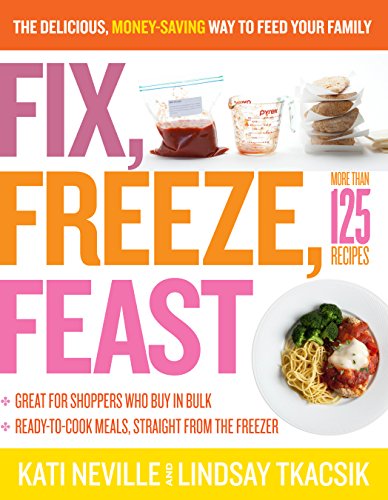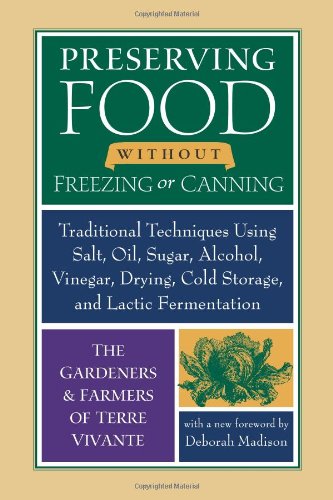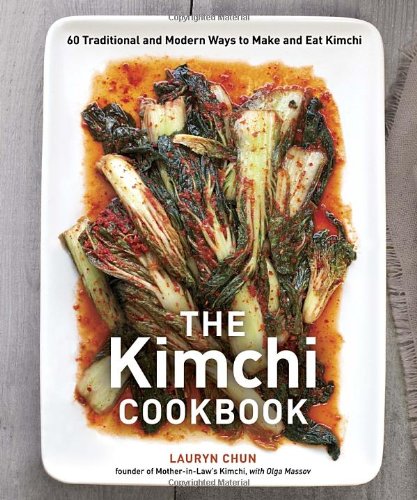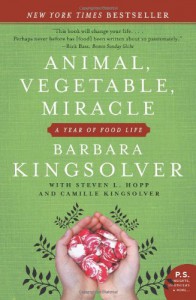
Since its original publication in 1998, this book has been considered the go-to guide for those who like it sour, salty, and tangy. Author Ziedrich goes far beyond the classic bread-and-butters and dills with recipes that showcase the worldwide popularity of pickling. There are chapters on fermented pickles, from Half-Sours to Turkish Mixed Pickles; on fresh pickles such as Pickled Beets; on cabbage pickles from around the world like Kimchi and Curtido; and miso and soy sauce pickles. Twenty-fiv
The Joy of Pickling: 250 Flavor-Packed Recipes for Vegetables and More from Garden or Market (Revised Edition)




















Pickle Me This,
Making pickles now belongs to that class of human activity that has lost its original raison d’etre and exist now chiefly (or is that chefly?) as an art form, done for its own sake. Pickling has become for cook or gardner what a manual transmission is to the driving enthusiast, or, more retro, horses. Or what calligraphy is to a letter writer in the age of email and texting. You do it not for the easy and unthinking way of coasting through your days.
We had to pickle in the days before refrigeration. Now it is done for the sake of special flavors that can be had with salt and vinegar over time. There are not many real books on the subject. You see far more on canning and preserves. The Joy of Pickling is a slightly tongue in cheek title on the best book I haver ever seen on the subject. It helps to have a faintly daft teacher such as Ms. Ziedrich in these briny arts. She is a monomaniac with a mission, sustained now well over a decade. As with Madame Curie, her calling was not a result of selfish pursuits. She never even cared much for pickled vegetables (cucumbers are only the beginning) herself, but ushered in by the cares of close ones that has taken over her life.
For us novitiates, Ms. Ziedrich begins with basics — helpful discussions of vinegar, salt, spices, tools and equipment. She understands the chemistry of pickling, therefore presenting things as simple proportions. Then off we go into Part 2: Fermentation, covering twenty-five applications after a few more basics. You can pickle from just a pint at a time, for those of you daunted by visions of vats, barrels and $400 crocks (I kid you not). This second edition updated a sturdy working original of ten years past. The addition of the venerable Lower East Side “Full Sour” dill is reason enough, but she has added many relishes and other fine points. She also took considerable pains to clarify the recipes and the discussions of mechanics. We are ever more assured of success across a broad array of tasty bits.
Part 3 is devoted to Fresh Pickles, meaning, not fermented. For those of you who must minimize salt use, this is the domain of vinegar.
Part 4 conquers cabbages. I still remember the dressing down when my father discovered I poured out the sauerkraut juice. Now I know why.
Part 5 takes us from Kimchi into the deep waters of Asian Pickling
Part 6 is Sweet Pickles. If you guess nothing is here for you, 2/3 of this section is for fruit.
Part 7 is Quick pickles of all sorts in two or fewer days. Do some of these while waiting for fermentation to kick-in on day three.
Part 8 is completely new to me: Freezer Pickles. Just six sweet recipes for a year’s storage, even if only in freezer bags.
Part 9 is her beefed-up relish section. I am an old-fashioned relisher of these. They were popular so long for reasons only recently undone by tired and gooked-up store bought stuff. Time to revive:
– Piccalili
– Chow-Chow
– Corn relishes
– Mango chutney
– Walnut ketchup
– Chili Sauce
– Prepared Horseradish (hi-test)
All tried and true powerhouses to amplify or accent your food.
Finally, Part 10 leaves off the leaves and goes for meat, fish and eggs.
To the tune of Catch a Falling Star:
“Catch a Pickled Herring
Put in in a Barrel
Save it for a Rainy Day
Never let it Rot Away…”
Ms. Ziedrich will encourage the timid and satisfy the accomplished. Corned Beef is your PhD dissertation. You want souce? You have a delightful, achievable one here. Once you get going, you can push the barrel. Recommended ages 13 to 93.
Was this review helpful to you?

|Straight to the head of the class!,
Here in New England late summer harvest is in full swing so The Joy of Pickling, Revised Edition: 250 Flavor-Packed Flavor-Packed Recipes arrived last week right on time to be put to good use. And put to use it has certainly been – with luscious results.
One thing our Grandmas knew was that pickles sparked up dull winter fare like nothing else could, so much so that our Pennsylvania Dutch Grandmas were famous for serving “seven sweets and seven sours” on their dinner tables! What they might not have known is that pickles are good for you, loaded with Vitamin C, and sometimes the B vitamins. Now, if you’re looking for 101 varieties of pickles like your Grandma and her Grandma used to make by the bushel, then there are better – or at least more extensive – books to be had and you’ll find a multitude of recipes for them in just about every general American cookbook to boot.
However, if what you are looking for is the unusual, then send The Joy of Pickling straight to the head of the class. Whether you are looking for Polish Pickled Mushrooms (big jar sitting in the fridge) or Korean style Pickled Garlic (Mrs. Kim’s – sitting on the counter) or the Pickled Limes featured in Little Women, you’ll find the recipe here.
Perhaps what you want is Moroccan Pickled Lemons? Or would you prefer the sweeter Indian version? Some Pickled Blueberries to set off your Thanksgiving meal? Or perhaps some Thai Pickled Carrots that you can serve with dinner an hour from now? (We had that two nights ago – yum!) Linda Ziedrich gives us recipes for a world of pickles – pickles from Russia and Japan, from India and Italy and about every place in between. These are the lost recipes your Grandma brought from the old country, the right pickles to go into the bento box, to provide the real flavors of “elsewhere.” All of them easy, nothing complicated. And a good many of them that can be ready to eat tonight, tomorrow or at least by the end of the week.
And because she does, The Joy of Pickling makes my very short list of books that live on my kitchen counter, that move in my hands rather than the 17 boxes I’m still unpacking. This is a book that I will pass on to my daughters along with Mastering The Art of French Cooking, the Joy of Cooking and Charleston Receipts. Kudos for a job extremely well done. If I could give it 6 stars, I would!
Was this review helpful to you?

|Kinda disappointed,
I first got this authors new Jams & Jellies book, which I love. I’ve made a lot of homemade jams and I appreciated the organization of the book (by ingredient) and and recipes.
This book just didn’t live up to the same. Perhaps it is different, because I’ve never pickled before I was far more careful reading this one’s introduction section. But I found it less useful.
I have two main gripes.
At the beginning when explaining the types of pickles she fails miserably at actually explaining the difference. She says “there are two kinds of pickles, ones preserved with vinegar, and ones preserved with salt. But the salt ones contain vinegar sometimes and the vinegar ones usually still have salt. ” I’m paraphrasing of course but that is about it.
Well, I was confused, and I continued reading, and I continued being confused. Then, Alton Brown’s Good Eats had an episode about pickles and he answered it in about 10 seconds what she couldn’t do in an entire chapter “Pickles are preserved with acid, with vinegar pickles you add the acid in the form of vinegar, with fermented pickles lactic acid produced during fermentation provides the acid.”
Far more useful, far more informative. I get the feeling the author either had the wrong information, or was just trying to be clever with her phrasing and the accuracy suffered. It wasn’t vinegar or salt, it was vinegar or lactic acid. Salt isn’t an acid.
My second gripe is that she talks about pickled brussel sprouts a few times in the opening chapters, and this excited me because I had a bounty of sprouts from my garden at that time, and then, not a single recipe. Anything you mention in the introduction chapters should have a recipe in the back.
Was this review helpful to you?

|